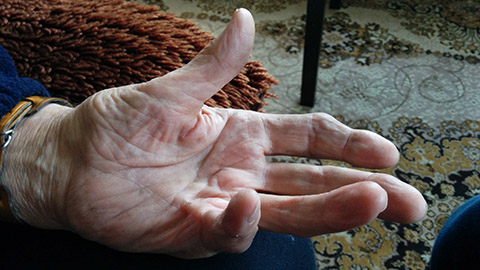
A client has Dupuytren’s contracture, a progressive thickening and shrinking of the palmar fascia that causes her pinky finger to be bent all the time. Now it seems to be starting on the other side.
Is massage safe? Can it help slow the progress? What is Dupuytren’s contracture, anyway?
Resources:
Alraek, T. et al. “Complementary and Alternative Medicine for Patients with Chronic Fatigue Syndrome: A Systematic Review,” BMC Complementary and Alternative Medicine 11 (2011): 87. https://doi.org/10.1186/1472-6882-11-87.
Foundation for Mitochondrial Medicine. “Chronic Fatigue Syndrome.” May 24, 2018. www.mitochondrialdiseases.org/related-diseases/chronic-fatigue.
Jacobson, Eric. “Structural Integration, an Alternative Method of Manual Therapy and Sensorimotor Education,” Journal of Alternative and Complementary Medicine 17, no 10 (2011): 891–99. https://doi.org/10.1089/acm.2010.0258.
Jones, James. F. et al. “Complementary and Alternative Medical Therapy Utilization by People with Chronic Fatiguing Illnesses in the United States,” BMC Complementary and Alternative Medicine 7 (2007): 12. https://doi.org/10.1186/1472-6882-7-12.
MECFS_KeyFacts.pdf. Accessed July 2021. www.nationalacademies.org/hmd/~/media/Files/Report%20Files/2015/MECFS/MECFS_KeyFacts.pdf.
NINDS. “Myalgic Encephalomyelitis/Chronic Fatigue Syndrome Standards.” Accessed July 2021. www.commondataelements.ninds.nih.gov/MECFS.aspx#tab=Data_Standards.
Wang, Ji-hong et al. “Effects of the Intelligent-Turtle Massage on the Physical Symptoms and Immune Functions in Patients with Chronic Fatigue Syndrome,” Journal of Traditional Chinese Medicine 29, no. 1 (2009): 24–8. https://doi.org/10.1016/S0254-6272(09)60026-1.


This podcast sponsored by:
About Anatomy Trains:
Anatomy Trains is a global leader in online anatomy education and also provides in-classroom certification programs forstructuralintegration in the US, Canada, Australia, Europe, Japan, and China, as well as fresh-tissue cadaverdissectionlabs and weekend courses. The work of Anatomy Trains originated with founder Tom Myers, who mapped the human body into 13 myofascial meridians in his original book, currently in itsfourthedition and translated into 12 languages. The principles of Anatomy Trains are used by osteopaths,physicaltherapists,bodyworkers,massagetherapists,personaltrainers,yoga,Pilates,Gyrotonics,and other body-minded manual therapists and movement professionals. Anatomy Trains inspires these practitioners to work with holistic anatomy in treating system-wide patterns to provide improved client outcomes in terms of structure and function.
Website:anatomytrains.com
Email:info@anatomytrains.com
Facebook:facebook.com/AnatomyTrains
Instagram: instagram.com/anatomytrainsofficial
0:00:00.0 Speaker 1: Ruth Werner's best-selling book, A Massage Therapist's Guide to Pathology, is a highly regarded comprehensive resource that sets the standard for pathology education. Written for massage therapy students and practitioners, this ground-breaking resource serves up a comprehensive review of the pathophysiology signs, symptoms, and treatment of more than 500 diseases and disorders. Learn more at booksofdiscovery.com.
0:00:32.4 Speaker 2: Anatomy Trains is happy to announce our return to the dissection lab in person, January 10th to the 14th, 2022 at the Laboratory of Anatomical Enlightenment in Boulder, Colorado. We are thrilled to be back in the lab with Anatomy Trains' author, Tom Myers and master dissector, Todd Garcia. Join students from around the world and from all types of manual, movement and fitness professions to explore the real human form, not the images you get from books. This is an exclusive invitation. Email info@anatomytrains.com if you'd like to join us in the lab.
[music]
0:01:17.2 Ruth Werner: Hi, and welcome to I Have A Client Who, pathology conversations with Ruth Werner. The podcast where I will discuss your real life stories about clients with conditions that are perplexing or confusing. I am Ruth Werner, author of A Massage Therapist's Guide to Pathology, and I have spent decades studying, writing about and teaching about where massage therapy intersects with diseases and conditions that might limit our clients' health. We almost always have something good to offer, even with our most challenged clients, but we need to figure out a way to do that safely, effectively and within our scope of practice. And sometimes, as we have all learned, that is harder than it looks.
0:02:03.6 RW: This week's episode is brought to us by a massage therapist in Colorado, who shares this. I have a client with Dupuytren's contracture in her pinky finger. Can or should I work on her finger? If yes, what do I need to know before starting? Will manual therapy hurt it, or exacerbate the problem? Can manual therapy help it? Also, it has a slow progression, could manual therapy help in the early stages? I did wonder if early prevention would do anything though, because it is starting on her other pinky. So, it sounds like we have a couple of things going on here. Dupuytren's contracture seems to be well established in at least one finger of one hand of this client and maybe getting started in the other, and our contributor wants to know if massage might help or even prevent it? As it happens, this is something I have wondered about as well, so I'm glad to have a reason to dig in a little bit. Let's start with some basics.
0:03:01.3 RW: Dupuytren's contracture is a condition named for Guillaume Dupuytren, a French anatomist and military surgeon who was according to Wikipedia famous for having treated Napoleon Bonaparte's hemorrhoids, but he's also known for this condition, which was named for him in 1831. A quick peek into his story reveals some fascinating rabbit holes to go down, but for now, we'll just stick to Dupuytren's contracture. This is a situation in which the connective tissue of the palm of the hand shrinks and it often pulls the fingers down as it progresses. It has another name, palmar fibromatosis. In other words, a benign tumor of fibrous tissue, that's a fibroma on the palm of the hand. The word tumor here doesn't suggest cancer, it just describes a growth. Lots of times Dupuytren's contracture begins with nodules or growths that seem to be embedded within the thickening shrinking fascia. Dupuytren's contracture is most common among people of Northern European descent. This is predictable enough that it has yet another name, Viking's disease.
0:04:09.4 RW: Numbers on Dupuytren's contracture are tricky to gather, because not everyone who has the condition requires treatment. We think about 4% of the United States population has it, but only about three million people, and that's still about 1% of our total population have had distortions in their fingers related to this disease. It is most common in middle-aged people and men are affected much more frequently than women, depending on the age group. There are some statistical correlations between having Dupuytren's contracture and having a history of hand trauma, diabetes, doing a lot of physical labor that involves vibration in the hands, smoking and using alcohol. There are some overlap with other situations as well, like, complex regional pain syndrome, but hand trauma, diabetes, and a lot of physical labor appear to be the most common connections. So what is happening in the connective tissue in Dupuytren's contracture?
0:05:13.0 RW: Many experts seem to agree that this is mainly a genetic condition, but those genetic anomalies may be triggered by other factors, like the smoking or the diabetes or the hand trauma. The net result is the proliferation of fibroblasts and pro-inflammatory cytokines that promote even more fibroblasts and myofibroblasts. The myofibroblasts are a signal to contract and to produce Type 3 collagen, and this is not normal in palmar fascia. Type 3 collagen is found mostly in the structural materials that help form our arteries and the GI tract. We don't typically find a lot of it in fascia, near the surface of the body. All this extra connective tissue activity usually affects the palmar fascia as it leads to and covers the flexor tendons of some of the fingers. As the condition progresses, often over months or years, the fascia tightens and these palpable cords develop that pull the fingers inward. Most people find that their pinky and ring fingers are affected most severely, but this can vary, and some patients have shrinking and thickening in the palmar fascia that does not extend out to the fingers, it is only in the center of their hand. Others may lose the use of their fingers entirely.
0:06:32.6 RW: One of my favorite actors, Bill Nye has Dupuytren's contracture. And if you watch Emma or Love Actually, or any of the other dozens of wonderful movies that he's been in, you will see that he never opens his hands all the way. Other famous people with Dupuytren's contracture, at least according to the website diseasemaps.org, include Bill Murray, Mitt Romney, Frank Sinatra, Paul Newman, Margaret Thatcher and Ronald Reagan. Did you notice anything interesting about that list? Yup, mostly men, which makes today's contributor a little bit unusual, but we'll get back to her in a moment. First, let's talk about her treatment options. There are about a gazillion options for treating Dupuytren's contracture, and there's a lot of debate about which ones are best. It seems to depend on timing and severity, which makes sense, if the progress can be interrupted early, well, that's preferable, but if the condition is well established and severe, then those options that might work for an earlier stage are just not going to work anymore.
0:07:35.8 RW: Early interventions can range from stretching, exercise, heat, splinting, and ultrasound, but later, we might be looking at injections or various types of surgery. Collagenase injections use enzymes to dissolve excess collagen. This is an option if the stretching and splinting and exercise and other non-invasive options don't work. The injection happens on the first day of treatment and then that cord is ruptured through passive extension on the next day. Sounds delightful. Not surprisingly, some adverse events have been reported with this intervention, but it is still much less risky than hand surgery, which may be necessary if the fingers are very limited in their range, especially at the proximal interphalangeal joints. There are a couple of types of hand surgery, fasciectomy and percutaneous needle fasciotomy. If surgery is required, follow up care is absolutely vital to reduce the chance that post-surgical scar tissue will make the whole situation much worse.
0:08:42.3 RW: And this follow up care may include massage therapy, so education in scar tissue management would be an excellent skill to bring to this situation. All of the treatments for Dupuytren's contracture, the early ones, the injections and surgery, all have a high rate of recurrence. As I prepared for this podcast, I found an interesting website about Dupuytren's contracture treatment research, it's called Dupuytren disease and Dupuytren Research Group, and I will put a link in our show notes. This group is soliciting information from patients all over the world to help gather data, not just on hand deformity, but on the biology of affected people, and this is called the International Dupuytren Data Bank. Their hope is to learn enough to be able to streamline the diagnosis and treatment processes for more effective treatments and better outcomes. Okay, so, what about the person described by today's contributor? She's unusual because she's a woman with this condition, however, she is also middle-aged, which puts her right smack in the middle of this demographic.
0:09:51.4 RW: And just as a reminder, here are the original questions. I have a client with Dupuytren's contracture on her pinky finger, can I or should I work on her finger? And if yes, what should I know before I get started? Will manual therapy hurt or exacerbate the problem? Can manual therapy help and could manual therapy help in early stages as a prevention? Well, an answer to question number one, can or should I work on her finger, what do I need to know before starting? Here you go. Sure, it's fine to work with her finger and with the rest of her hands, as long as sensation is intact. There's nothing about Dupuytren's contracture that seems to cause numbness or in other nerve issues, so any massage that doesn't hurt is probably completely fine. What do you need to know ahead of time? Well, that this is a genetic condition and massage is frankly unlikely to influence it in any major way.
0:10:49.5 RW: Question number two, will manual therapy hurt it or exacerbate the problem? Only if you work so deeply that you injure your client. Can we agree that that's not a good plan. If so, then no, manual therapy within pain limitations will not hurt or exacerbate this problem. Question number three, could manual therapy help in early stages, because it's starting on her other pinky? Ah, there is the million dollar question. The progression of Dupuytren's contracture varies a lot from one person to another. For many patients it plateaus early and doesn't get worse, but for others, it can cause the loss of function of multiple fingers. Sometimes that progression is really slow and sometimes the progression is much faster. And the issue of whether massage, stretching, exercises or other interventions that are within our scope can help is an open question. Given what I have learned about Dupuytren's contracture, and I've had a couple of friends with this condition who have allowed me to ask some pretty specific questions, I frankly am not very optimistic that massage can prevent this process. Maybe, maybe it can slow it down, but that of course is really hard to test.
0:12:06.3 RW: My suggestion is to go ahead and work with his client's hands as much as it's comfortable for her. Do massage, friction, stretching, exercise the flexors and extensor tendons, and also teach her how to do some of this for herself. So instead of getting attention once a week or however often this person gets massage, her hands can receive this kind of attention every day. And then, and you probably know what's coming next, ask your client to track her results. If her progression stops or slows down, maybe you can make a case that massage therapy helped. If it speeds up, which would be surprising, but we have to consider it possible, well, that's important information too. Above all, you now have the opportunity to gather some good information about massage therapy for this fairly common condition, so please do that and share it with your profession. Do you need some help with that? Let me know and I'll be happy to help out.
0:13:03.8 RW: Hey everybody, thanks for listening to I Have A Client Who, pathology conversations with Ruth Werner. Remember, you can send me your I Have A Client Who stories to ihaveaclientwho@abmp.com. That's ihaveaclientwho, all one word, all lower case @abmp.com. I can't wait to see what you send me and I'll see you next time.
[music]